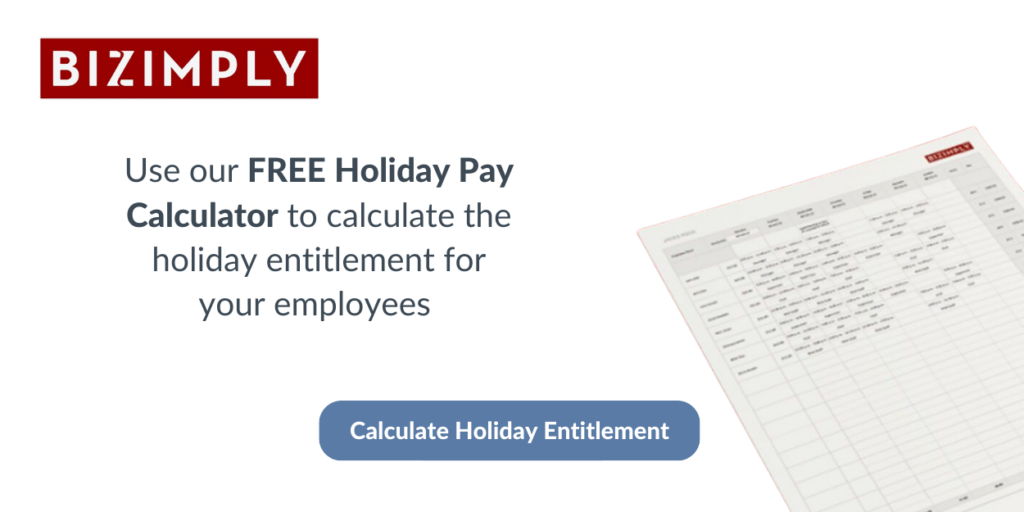The 12.07% method for calculating the holiday pay hours of UK casual workers on permanent contracts is no longer a valid approach.
What is Holiday Entitlement?
Holiday Entitlement is the legal amount of time off you are entitled to.
Almost all legal UK workers are entitled to 5.6 weeks of paid holiday a year.
When an employee or worker takes a holiday, they should get the same pay when they’re on holiday as when they’re at work – whatever their working pattern.
Some employers might offer better holiday pay schemes. You should check your contract.
Holiday pay calculations can be based on:
- days or hours worked per week,
- casual or irregular hours,
- Shifts
Keeping track of this calculation can be complex. Especially if you have a different one for each employee.
That’s why we’ve added a report to Bizimply for our UK customers. Let us calculate employee holiday entitlement for you.

Want to know more about Bizimply reports? Book a 15-minute free consultation!
What holiday entitlement does a part-time employee get?
For all employees, the minimum statutory holiday entitlement is calculated by multiplying the number of days worked per week by a factor of 5.6.
The result (capped at 28 days) is the number of days of annual leave that the worker is statutorily entitled to.
What is a 52-week average Holiday Pay Scenario?
Let’s use an example of waiting staff who works certain hours on particular days, but isn’t a salaried employee. They are still entitled to holiday time off and pay, but you will need to use these new regulations to determine their compensation.
First, let’s say we have found 52 weeks of data within the last 2 years. The total income made was £30,000; now, let’s figure out how much holiday pay this worker would be owed if they requested a week off.
So, with the total income known, we have Step 1 done.
Step 1: Finding the average weekly income
Let’s move on to Step 1 and find the average weekly income for the last 52 weeks:
£30,000 (Total Income) / 52 (Number of weeks) = £576.92 (Avg Weekly Income)
The waiting staff is requesting 1 week off; £576.92 would be the amount you owe your employee for their holiday pay.
Step 2: Finding the average number of daily working hours
Next, let’s figure out their average daily hours.
1,000 (No. of hours worked during the last 52 weeks) / 150 (No. of working days in the previous 52 weeks) = 6.6 (Average number of hours per working day)
So, for every day this employee requests off, you should pay for 6.6 hours of work.
Step 3: Finding the holiday pay
Finally, let’s calculate their holiday pay for 3 days off, assuming the employee’s hourly rate is £30.
30 (hourly rate) x 3 (days off taken) x 6.6 (average number of hours per working day) = £594
If we were to calculate the average number of working days per week for this worker, we would find 150 (total number of working days during the last 52 weeks) /52 = 2.88 days per week. This makes it very unintuitive and complicated to calculate the holiday pay of this employee.
What if I don’t have 52 weeks worth of data?
New regulations state that you should use every single week of pay data you do have up to the 104-week timeline (2 years)
So, let’s try this process again, but with less than 52 weeks’ pay as an example during the 104-week timeline.
In this scenario, we will assume the employee has 24 weeks of pay data and has made a total income of £15000.
£15000 (Total Income) /24 (Total Weeks) = £625 (Average Weekly Pay)
We will assume this employee works 500 hours across 70 days during these 24 weeks.
500 (Total hours) / 70 (Total days) = 7.14 (Average hours worked per day)
We’ll say this employee wants to take 2 days off.
30 (Hourly rate from the previous example) x 2 (Days off taken) x 7.14 (Average number of hours per working day) = £428.4
Now, as you can see, the numbers can vary depending on how many weeks of work you can reference for the same employee.
How are public holidays calculated for part-time workers?
Bank holidays as paid leave are optional, but many companies do choose to include them as part of the annual leave entitlement.
For part-time annual leave, the same 5.6 factor is used.
For example – if an employee is working three days a week, they’d be entitled to 16.8 days’ holiday. As 5.6 x 3 = 16.8.
Part of a day is difficult to take as a holiday, so part days are generally rounded up to keep things simple.
Most of the UK’s bank holidays fall on a Monday or Friday.
In companies that give paid bank holidays, and where part-time employees don’t usually work on these days, those part-time employees would receive fewer days’ leave than full-time staff.
Many companies give their part-time employees a prorated bank holiday allowance.
This is calculated based on the number of hours worked, regardless of the days that are worked and irrespective of whether or not they would be bank holidays.
Use our Holiday Pay Calculator below to calculate the holiday entitlement for your employees:

Holiday Pay Is No Longer Pro-Rated
Part-year employees must receive 5.6 weeks’ holiday each year.
If they work regular hours, they would receive 5.6 weeks of normal pay a year as holiday pay and if they work irregular hours, the employer must look back over the previous 12 weeks at the time that holiday is taken to calculate the holiday pay.
From April 2023, the 12-week period will be extended to 52 weeks (or the full period of their employment if they have not been employed for 52 weeks).
“Workers under permanent contracts are entitled to 5.6 weeks’ holiday per year, regardless of the amount of work they do. Pay must be calculated in accordance with the legal provisions for holiday pay and not the 12.07% method.”
(Lewis Silkin LLP)
Where does this leave the law on holiday entitlement and pay?
This does not impact “classic” part-time workers with set hours.
For example; those who work a 3-day week. You can still calculate their holiday entitlement as a reduced number of days compared to a 5-day week worker because in practice they will end up with 5.6 weeks of holiday at their normal rate of pay.









